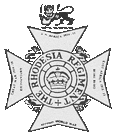Son of John and Helene Hamilton.
Husband of Anna Gurtruida Hamilton of 1372 Fife Street, Bulawayo, Rhodesia with who he had two children named John and Molly.
Buried at Taveta Military Cemetery, Kenya. Grave Reference V. A. 15.
Based around the overflow of volunteers for the 1st Rhodesia Regiment, a core of personnel for a second Southern Rhodesian expeditionary unit was in place by November 1914. This was made into the 2nd Rhodesia Regiment (2RR) during December 1914 and January 1915. The 1st Rhodesia Regiment's lack of combat experience thus far influenced those men in Southern Rhodesia who were yet to enlist; many Rhodesian colonials were keen to fight on the front lines, and some resolved that they might have to travel to Europe to be sure of doing so. Aware of this competition with the Western Front for the colony's manpower, recruiters for the 2nd Rhodesia Regiment took great care to assure potential inductees that they would definitely see combat, in Africa, if they signed up for the new unit. The 2nd Rhodesia Regiment ultimately had a paper strength of 500 men, the same as the 1st. Thirty black scouts, recruited in Southern Rhodesia, were also attached to the regiment.[69]
Because it was raised with less urgency, the 2nd Rhodesia Regiment received better training than the 1st. The course lasted eight weeks, a fortnight longer than the original regiment's training period, and focused heavily on route marching, parade drill, and, in particular, marksmanship—recruits were trained to shoot accurately at ranges of up to 600 metres (2,000 ft). The 2nd Rhodesia Regiment left Salisbury on 8 March 1915, moving east to the port of Beira in Portuguese Mozambique, from where they sailed to Mombasa in British Kenya, on German East Africa's north-eastern flank. Travelling aboard the SS Umzumbi, the battalion disembarked in Kenya less than a week after leaving Salisbury. It was immediately sent inland to the operational area around Mount Kilimanjaro, within sight of which it set up camp. On 20 March, the regiment was inspected by General J M Stewart of the Indian Army. "I had expected to see a regiment that would require some training," Stewart said; "I will pay you the highest compliment by sending you to the front today." So began the 2nd Rhodesia Regiment's contribution to the East African Campaign.[69]
The 2nd Rhodesia Regiment operated with some success during its first year on the front. It usually defeated German units that it encountered, but the Germans, using proto-guerrilla tactics, tended to retreat before they could be overrun.



